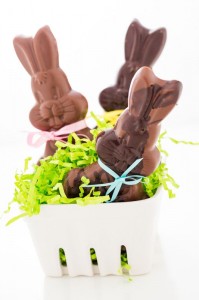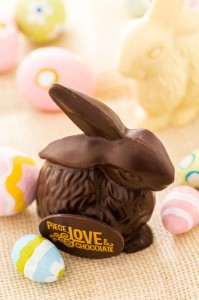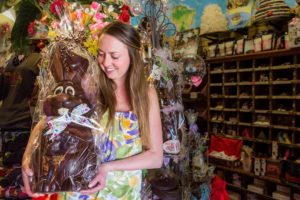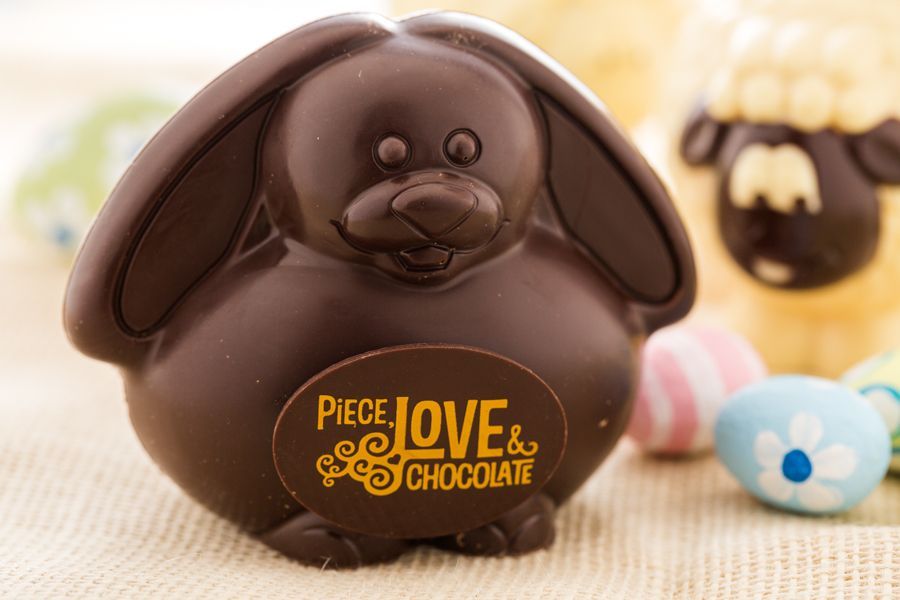 Which Came First; the (chocolate) Rabbit or the Egg?
Which Came First; the (chocolate) Rabbit or the Egg?
-Chef Sarah
Ahhh Easter – such a fun chocolate holiday – one of my most favorites! Everyone seems so enamored of consuming cute little creatures and eggs created from chocolate, jellies and marshmallow! But, have you ever wondered why we follow this tradition and where it originated from?
Since before medieval times, the rabbit and the egg have long been a symbol of both spring and fertility. Because of this symbolism with renewal and rebirth, you can see why both have been adopted into many religions as sacred and beloved images. Because rabbits are such quick and prolific procreators, it was once thought that the rabbit was able to conceive without copulation because no one had ever witnessed “bunny love”. Early Christians considered this a miracle of sorts, perhaps equating this somehow to the Virgin Mary’s conception of Jesus, and the rabbit became a holy symbol throughout Christendom.
On an interesting side note: rabbits can be pregnant twice at the same time with two different litters spaced weeks apart. If that’s not miraculous, copulation aside, I don’t know what is!
In Germany, you can see many old churches with stone carved embellishments of rabbits in groups of three, representing the Holy Trinity. Over time, the symbol of the rabbit was changed into the Easter Bunny. In Germany, the Osterhase or Easter Bunny magically laid eggs of which he carried in a basket and delivered to children as gifts on Easter morning. Back then, these were regular decorated duck and chicken eggs – not chocolate.
Cacao did not come to Europe until Hernan Cortes and his band on not-so-merry men brought it back from the court of the Meso-American Aztec king, Moctezuma II. It was another couple of centuries plus before the Europeans developed the knowledge of how to create chocolate from cacao and mold it into shapes. Up until then, cacao was consumed only as a liquid pleasure.
On another interesting side note: Early European molds were created from tin-coated or silver-plated copper, because it was soft and easy to press an image into it. However, when the plating began to wear thin, the ensuing verdigris of the copper oxidation was poisonous. Chocolatiers wanting to preserve repeat business began creating chocolate molds from various other nickel-plated metals. Eventually, easy to use plastic molds became available (can you say hallelujah?!?).
Chocolate molds were made for all kinds of images, but with many people abstaining from pleasures such as delicious chocolate during Lent, French and German chocolatiers saw a business niche to reward those on Easter with symbolic chocolate eggs and bunnies. However, leave it to the Americans to “go big or go home” as it may well remain known that in 1890 a Pennsylvania druggist went down in in history as the “father of the chocolate Easter bunny” when he displayed a five-foot high chocolate bunny is his shop as an Easter promotion. As you can imagine, sales of chocolate Easter bunnies began to take off.
 Over ninety million chocolate Easter bunnies are produced every year (sixty million are consumed in the U.S. alone); most of which are hollow. This wasn’t always the case. Almost all chocolate bunnies were sold as solid pieces until World War II, when the War Production Board put mandatory rations on chocolate and cocoa, forcing chocolatiers to become creative. They were still able to use their existing molds, but by making the finished pieces hollow, they were able to deliver desired treats and conserve ingredients.
Over ninety million chocolate Easter bunnies are produced every year (sixty million are consumed in the U.S. alone); most of which are hollow. This wasn’t always the case. Almost all chocolate bunnies were sold as solid pieces until World War II, when the War Production Board put mandatory rations on chocolate and cocoa, forcing chocolatiers to become creative. They were still able to use their existing molds, but by making the finished pieces hollow, they were able to deliver desired treats and conserve ingredients.
 So, in closing, we would like to wish you all a very Happy Easter! And, don’t forget, we have all sorts of chocolate bunnies and eggs in a variety of sizes and chocolates. In addition to that, we are in the process of creating an Easter Basket Bar where you can choose from over 20 different PL&C chocolates and confections to fill your Easter basket full. And while we don’t have a five-foot bunny, we do have “Jacques” – pictured here with Max. He is 31” high and weighs 30 lbs!!! If you like to eat the ears first (Jacques’s ears alone weigh 6.2 lbs) on your bunny, you are not alone. 76% of Americans claim to enjoy the ears first; only 4% eat the tail first. “…hippity, hoppity, Easter’s on its waaaay!” And we do mean in a really, really, big way here at 805 Pearl Street!
So, in closing, we would like to wish you all a very Happy Easter! And, don’t forget, we have all sorts of chocolate bunnies and eggs in a variety of sizes and chocolates. In addition to that, we are in the process of creating an Easter Basket Bar where you can choose from over 20 different PL&C chocolates and confections to fill your Easter basket full. And while we don’t have a five-foot bunny, we do have “Jacques” – pictured here with Max. He is 31” high and weighs 30 lbs!!! If you like to eat the ears first (Jacques’s ears alone weigh 6.2 lbs) on your bunny, you are not alone. 76% of Americans claim to enjoy the ears first; only 4% eat the tail first. “…hippity, hoppity, Easter’s on its waaaay!” And we do mean in a really, really, big way here at 805 Pearl Street!

